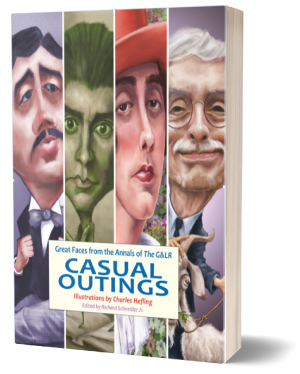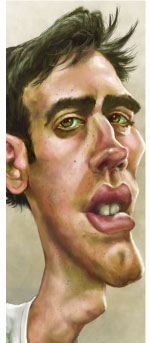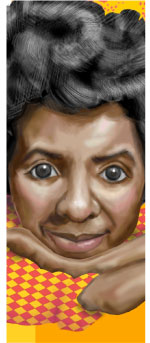The Art of Charles Hefling

Casual Outings will be available on B&N and Amazon in both paperback and as an ebook.
Casual Outings
Great Faces from the Annals of the G&LR
Illustrations by Charles Hefling
Edited by Richard Schneider Jr.
A retrospective on the art of Charles Hefling
In celebration of the 150th Issue of The G&LR
The Gay & Lesbian Review / Worldwide
THE OCCASION for this book is the publication of the 150th issue of The Gay & Lesbian Review, which sets up something of a cosmic joke. Since the book is essentially replacing the issue that’s being celebrated, that very issue does not in fact exist! Instead, this book of art and text is offered as a look back over the last 27 years as told by our Contributing Artist for most of that time, Charles Hefling, whose illustrations are featured along with a précis about each writer or artist from the annals of The G&LR.
The selection of illustrations was guided by a privately published collection of Hefling’s work titled No Straight Faces, which included many of the artist’s “A List” caricatures from the magazine (plus a few more). These were offered without text, usually two to a (horizontal) page, arranged according to the artist’s inimitable æsthetic. As an editor, my first instinct was to look for a narrative structure by which to organize these many faces. For starters, I confess I found the pairing of high culture and popular culture—Marcel Proust sharing a page with Lou Reed—slightly jarring, so this was the first line of demarcation. This book contains only those in the “high culture” category. (Stand by for a possible sequel.)
The artists and writers featured here lived in times and places that did not partake of the relatively enlightened attitudes that make it possible for someone today to live openly as an LGBT person. To the extent that they deliberately concealed their sexual identity or even denied outright what seems to us a clear case, the conclusion that they were “gay” in our sense, or even that they had same-sex desires, requires some amount of interpolation or reading between the lines on our part (often not much, to be sure).
“Casual Outings” thus refers to the fact that we are in some sense “outing” people who tried to hide their sexuality at least some of the time. We’re doing it in a “casual” way because the same-sex orientation of figures like Whitman or Tchaikovsky or Amy Lowell has by now been pretty well established, however much their biographers may once have tried to conceal it. The spectrum from complete closetedness to embracing one’s LGBT identity follows a roughly chronological trajectory, as documented here for the 150-year period that’s covered here (if we ignore Michelangelo); and this evolution is reflected in Hefling’s illustrations.
The bookends for this period are the portrait of the exceedingly buttoned-down and bespectacled Franz Schubert, circa 1820, and that of the T-shirt-clad and actually quite hot David Wojnarowicz* in the 1980s. In between are figures who display a number of patterns of adaptation to existing social circumstances. There are those like Whitman, Proust, Mishima, or John Cheever who created gay personas in their work but could never quite admit the terrible truth in real life. Conversely, some artists and writers who were quite open about it as a personal matter were reluctant to come out in their work, like E. M. Forster (except in Maurice, which he suppressed), Langston Hughes, and Edward Albee. To be sure, a number of the figures presented here tested the limits of the prevailing sexual regime both in their private lives and in their work—Oscar Wilde, Radclyffe Hall, and Tennessee Williams come to mind—and they sometimes paid the price.
The 27 figures are organized here into five sections according to their major artistic endeavor: novelists, visual artists, dramatists (including Nietzsche, a minor stretch), composers, and poets. Within each section the figures have been arranged chronologically by birth date to give a sense of the evolutionary process noted above. While they all addressed universal themes and appealed to a wide audience, our concern here is the specifically “gay” aspect of their works as well as their private lives. The descriptions on the verso side of each two-page spread are excerpts from articles by some of our many illustrious contributors.
Let me end with a brief word about the art of Charles Hefling—brief because I really think his work speaks for itself. The illustrations shown here appeared in The G&LR over the past decade in what might be called Charles’ “modern” period. For our first ten years (starting in 1994), he did black-and-white line drawings that were classic caricatures à la Al Hirschfeld or David Levine. After a few years’ sabbatical, he returned to discover that we were now publishing in full color. Not a problem—Charles was already becoming proficient in computer apps that allowed him to paint digitally, and in color; and this capability gave rise to a whole new style of illustration: detailed three-dimensional portraits that go beyond the conventions of caricature and strive, not to exaggerate physical features, but to reveal something essential about the person being portrayed.
* Wojnarowicz is the one figure who probably doesn’t fit the “outing” criterion, as he lived and worked as an out gay man in the 1970s and ’80s. But it’s just such a great drawing.






